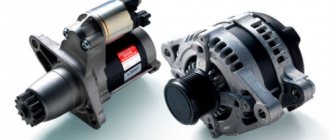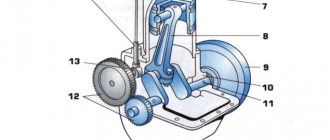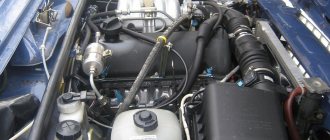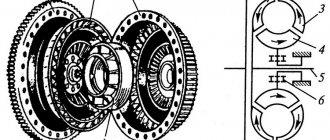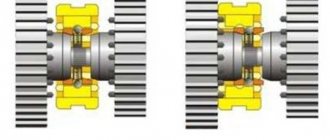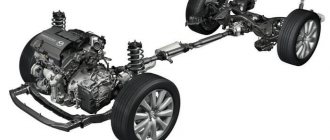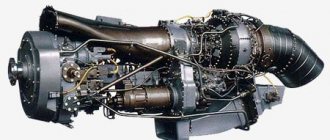Device and principle of operation
Impact sensors are located in various places of the car - front, rear, sides - which are activated if the car collides with an obstacle at a speed of more than 20 km/h.
The electronic control unit, which controls the operation of the airbags, receives signals from the sensors and the unit gives a command to operate.
The signal is sent to the airbag gas generator, after which the squib charge is fired. As a result, the acid in the gas generator burns, releasing a certain amount of gas, which fills the bag, opening the airbag.
In order to soften the airbag itself, there are holes on its surface that provide a quick (less than a second after activation) release of gas from the airbag.
In modern cars, the Airbag generator is equipped with two squibs. The first is designed for relatively light collisions and releases approximately 80% of the gas. If this is not enough, the second cartridge fires. It releases the remaining gas, making the Airbag somewhat stiffer.
The pillows themselves are made from nylon-based fabric with the addition of starch or talc as a lubricant. The design of the pillows is provided in such a way that in standby mode they, in a compact, folded form, can easily fit in the steering wheel, on the front panel or in the sides of the seats.
What's next?
So, over the past 30 years, airbags have gone from being a fancy accessory for expensive cars like the Mercedes-Benz S-class to becoming an absolutely mandatory attribute of any modern car, including in Russia (with rare exceptions). A modern driver will think ten times before getting into a car without airbags.
One can only guess how pillows will develop in the future. Most likely, they will simply become even more widespread: production technology will gradually become cheaper, and the day is not far off when we will see budget cars with a full set of airbags, including knee and curtain airbags. Perhaps designers will pay more attention to the safety of rear passengers, and, of course, Volvo's pedestrian protection technology should be widely used.
Airbags were originally developed in the USA as an alternative to the seat belt. Yankees are lazy people.
Main advantages of airbags
- Unlike seat belts, airbags do not require any action from the driver or passengers to activate. In the event of a dangerous situation, they are triggered automatically.
- The pillows do not restrict movement at all and do not cause a decrease in the level of comfort in the cabin. They are folded and invisible to the eye.
- The speed at which the airbag inflates is much faster than the occupants' normal reaction time in an accident. This leads to the fact that the protection of people inside the car is ensured regardless of the logic and sequence of their actions in a critical situation.
History of creation
The first prototypes of modern airbags appeared back in 1941, but the war disrupted the engineers' plans. Experts returned to the development of airbags after the end of hostilities.
It is interesting that two engineers were involved in the creation of the first airbags, working on different continents separately from each other. Thus, on August 18, 1953, American John Hetrick received a patent for a system he invented to protect against impacts on solid elements in the car interior. Just three months later - on November 12, 1953 - a similar patent was issued to the German Walter Linderer.
The idea of creating a device that softens the impact of an accident came to John Hetrick after he was involved in a traffic accident in his car. His entire family was in the car at the time of the collision. Hetrick was lucky: the blow was not strong, so no one was hurt. Nevertheless, the incident made a strong impression on the American. The next night after the accident, the engineer locked himself in his office and began working on the drawings, according to which the first prototypes of modern passive safety devices were later created.
The invention of engineers has been subject to more and more improvements over time. As a result, the first production versions appeared in Ford cars in the 70s of the twentieth century.
A spoon of tar. Some disadvantages of airbags
- Any, even the most modern electronics, is not ideal. The sensors responsible for triggering the airbag are also no exception. Accordingly, there is a possibility of a false signal. In this case, the airbag may even harm the driver.
- In side collisions or rollovers, the airbag is not particularly effective. Its main purpose is to prevent head and neck injuries from frontal contact.
- In the event of a collision, the airbag is filled with up to 100 liters of nitrogen in just a split second. And, if the people in the car are not wearing seat belts, contact with the airbag can lead to injuries and even fractures.
Important! The maximum effectiveness of airbags is achieved only in combination with the use of seat belts.
Even when using seat belts, there is a danger of injury when the airbag is activated, in case of improper entry into the car, crossed arms, etc.
And for pedestrians too
If you have a particularly tender love for pedestrians, then your car is the Volvo V40 Cross Country. This is the only car on the Russian market (and also the first production car in the world) that is equipped with an airbag for pedestrians. It is located under the hood and shoots, lifting it and covering almost the entire windshield. Unfortunately, this device does not protect you from broken legs (the edge of the hood and the bumper remain rigid), but it does protect you from a traumatic brain injury.
But how does the V40 understand that a collision occurred with a pedestrian, and not, say, with a pole? A thermal imager is responsible for this, which measures the temperature of the object the car is approaching from a distance. In addition to the unique airbag, Volvo also has a City Safety system with forced emergency braking. So, ideally, a pedestrian should not need a pillow at all.
Types of airbags
Based on the area of application, airbags can be divided into four subtypes.
- Frontal . They are located in the steering wheel (for the driver) and in the upper part of the front panel - to protect the passenger sitting next to the driver. Some cars have the ability to turn off the front passenger airbag. This is the most common type of airbag; almost all modern cars are equipped with such airbags.
- Lateral . They are built into the backs of chairs and are designed to protect the chest, pelvis and abdominal cavity. In a more complex and expensive design, the design of the side airbags involves the use of two chambers. The first, more rigid one, is located below and serves to protect the pelvis. Softer, upper, protects the chest.
- Head (or - “blinds”). As the name suggests, they serve to protect the head. They are located in the front and rear parts of the roof, between the pillars. They are used for both the front row of seats and the back row.
- Knees . Located under the steering wheel, they serve to protect the driver's knees and shins. There are also knee airbags for the front passenger. They are installed under the glove compartment on the front panel.
For motorcyclists and cyclists
In 2006, the first motorcycle with an airbag debuted, the big Honda Goldwing chopper. The pillow is built into its front panel and is generally similar to a car one. So far, the technology has not been widely used by competitors.
Motorcyclists, especially extreme riders, prefer… suits with pillows to “automotive” solutions. The capsule with it is located on the neck; when it falls, it opens like a collar, and instead of hard asphalt, the biker hits his head on soft fabric.
Security measures
You should always remember that airbags do not provide 100% protection in an accident. They significantly increase the chance of avoiding injury, however, only if certain rules are followed during operation.
- Always buckle up. As already mentioned, they are only effective when using seat belts.
- In a timely manner, check the performance status of all systems that interact with the airbag at specialized car services.
- Follow the rules for sitting level in a car prescribed back in driving school - “hands on the steering wheel”, etc.
- When transporting children, use only special child car seats with the appropriate airbag disabled.
Although airbags are not currently an absolute means of protection in an accident, they are constantly being improved. This trend, combined with strict adherence to safety rules, allows us to count on fairly good results in ensuring the safety and health of vehicle drivers and their passengers.
Airbag in modern cars
Today, airbags are installed in every car. Their number - from one to seven pieces - depends on the class and configuration of the vehicle. The main task of the system remains the same - to protect a person from a collision at high speed with elements of the car interior.
